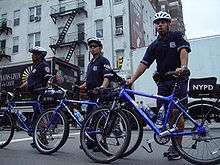Police bicycle
A police bicycle is a land vehicle used by police departments, most commonly in the form of a mountain bicycle. They are designed to meet the requirements unique to each department.
The maneuverability of these vehicles on crowded sidewalks and their ability to navigate narrow, crowded driveways offer advantages over cars, although a bicycle's top speed is lower.
Bicycle patrols are more common in temperate urban areas where limited coverage areas are available. The use of bicycles instead of cars can make police officers more easily approachable, especially in low-crime areas. Bicycles can also be issued to police officers to enhance the mobility and range of foot patrols. Bicycles are also effective crime-fighting tools when used in densely populated urban areas. The bikes are nearly silent in operation and many criminals do not realize that an approaching person on a bike is actually a police officer. Furthermore, if the criminal attempts to flee on foot, the riding police officer has a speed advantage while able to quickly dismount if necessary. In the average hour, a patrol car would have 3.3 contacts with the public, while bicycle patrols had 7.3 contacts with the public. The average number of people in contact with the police per hour was 10.5 for motor patrols and 22.8 for bicycle patrols. This information tells us simply that the activity level of police officers on bicycles is higher than that of the officers in cars.[1]
History

Police officers adopted the bicycle early in the 20th century, initially using their own. However, they eventually became a standard issue, particularly for police in rural areas. The Kent police[2] purchased 20 bicycles in 1896, and by 1904 129 rural police bicycle patrols were operating.
Some countries retained the police bicycle while others dispensed with them for a time. In the 21st century there has been renewed interest in police bicycles, since they provide greater accessibility to bicycle and pedestrian zones and allow access when roads are congested.[3]
Bicycle characteristics

The bicycles are custom designed for law enforcement use. Many manufacturers of bicycles offer police models, including Trek, Cannondale, Specialized, Fuji, Safariland-Kona, Force, and KHS. Other companies offer police, fire and EMS specific models. Many are equipped with a rear rack and bag to hold equipment.
Police bicycles' pedals are almost always flat pedals, sometimes outfitted with toe clips/straps, to allow for normal shoes to be worn (versus cycling-specific shoes that clip into "clipless" pedals), allowing officers to chase on foot if necessary.
They are equipped with front and rear lighting systems, with a water bottle battery. The lights can be LED, or halogen, or sometimes Xenon strobes. A headlight(s) are on the front, along with red or blue flashing lights. In the UK emergency service bicycles were allowed blue flashing lights from 21 October 2005. A red light is often attached to the rear of the bike.
Tires are usually semi-slick designs with smooth centers for street riding and mild tread or knobs on the outer edges to provide some traction if the bikes are ridden off a paved surface.
The National Institute for Occupational Safety and Health (NIOSH) has investigated the potential health effects of prolonged bicycling in police bicycle patrol units, including the possibility that some bicycle saddles exert excessive pressure on the urogenital area of cyclists, restricting blood flow to the genitals.[4] NIOSH recommends that riders use a no-nose bicycle seat for workplace bicycling.[5][6] In contrast, cycling expert Grant Petersen asserts that most modern saddles are designed to avoid excessive pressure on the urogenital area and that noseless saddles result in diminished bicycle handling capabilities.[7]
Training

The International Police Mountain Bike Association offers training as well as an annual conference called Police On Bikes. The course has its roots in John Forester's Effective Cycling. In the US the LEBA or Law Enforcement Bicycling Association help regulate standards of training for police officers.[8] LEBA offer officers three levels of certification.
Training topics may include, but are not limited to, hazards (visual and surface), nutrition, slow speed handling, community policing, traffic law, bike nomenclature, bike maintenance, night patrol, suspect approaches, and braking.[9]
Additional organizations, such as American Bike Patrol Services, also specialize in on-site bike patrol training for police and security bike patrols. [10] ABPS programs include special curricula designed for basic bike patrol and riding safety, offering one day certifications.
See also
- Bicycle infantry
- Outline of cycling
- Pacific Blue a TV series about a team of bike police officers
- Utility cycling for other uses of bicycles
References
- ↑ Menton, Chris (2008). "Bicycle patrols: an underutilized resource". Policing: An International Journal of Police Strategies & Management. 31 (1): 93–108. doi:10.1108/13639510810852594.
- ↑ "Kent Police Museum". Retrieved 2007-06-04.
- ↑ Rantatalo, Oscar (March 2016). "Using police bicycle patrols to manage social order in bicycle and pedestrian traffic networks". The Police Journal. SAGE Journals. 89 (1): 18–30. doi:10.1177/0032258X16639426.
- ↑ "NIOSH -Bicycle Saddles and Reproductive Health". United States National Institute for Occupational Safety and Health. Retrieved 2007-10-10.
- ↑ Schrader, Steven M.; Breitenstein, Michael J.; Lowe, Brian D. (2008). "Cutting off the nose to save the penis". The Journal of Sexual Medicine. 5 (8): 1932–40. doi:10.1111/j.1743-6109.2008.00867.x. PMID 18466268.
- ↑ "NIOSH Research Demonstrates the Effectiveness of No-Nose Bicycle Seats in Reducing Groin Pressure and Improving Sexual Health". CDC. October 2010.
- ↑ Petersen, Grant (2012). Just Ride. New York, NY: Workman Publishing Company, Inc. pp. 85–86. ISBN 978-0-7611-5558-4.
- ↑ LEBA
- ↑ "Police Training: Kevin Manz Talks Mountain Bikes". Tactical Gear News. 2011-04-25.
- ↑ ABPS
External links
| Wikimedia Commons has media related to Police cyclists. |
- International Police Mountain Bike Association
- Latest facts and figures on UK police on bikes
- Photograph of British Police bicycle in the 1960s
- Paul Sample. The History of Wiltshire Constabulary 1839–2003 (PDF).
- Bicycle Patrols TELEMASP Bulletin, Texas Law Enforcement Management and Administrative Statistics Program
